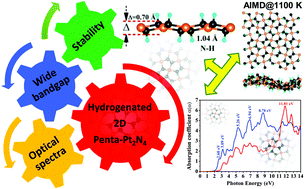Hydrogen-induced tunable electronic and optical properties of a two-dimensional penta-Pt2N4 monolayer†
Abstract
Most known two-dimensional materials lack a suitable wide-bandgap, and hydrogenation can be effectively utilized to tune the bandgap of some 2D materials. By employing density functional theory calculations, we investigate the effect of hydrogenation on the electronic and optical properties of a recently reported anisotropic penta-Pt2N4 monolayer. The results show that penta-Pt2N4 is thermally and mechanically stable after hydrogenation and also possesses anisotropic Young′s modulus and Poisson's ratio. The electronic property analysis using the hybrid functional reveals that penta-Pt2N4 exhibits a bandgap of 1.10 eV, and the hydrogenation significantly enhances the bandgap to 2.70 eV. Furthermore, the hydrogenated Pt2N4 displays a strong optical absorption of up to 6.45 × 105 cm−1 in the ultraviolet region, and low absorption and low reflectivity in the visible region. Our results strongly suggest that the hydrogenated Pt2N4 has tunable electronic and optical properties for applications as a hole-transport material layer in solar cells in the visible region, and as an ultraviolet detector in the ultraviolet region of the electromagnetic spectrum.



 Please wait while we load your content...
Please wait while we load your content...